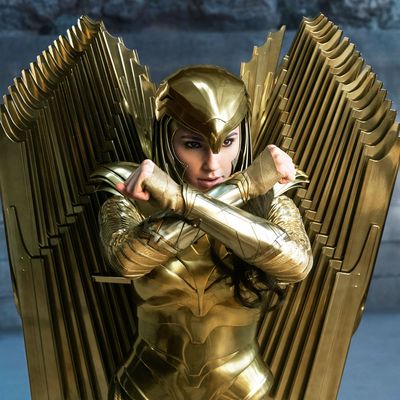
In the 1970s, the catchiest superhero theme song contained lyrics about someone wearing “satin tights” and “fighting for your rights.” Oddly, neither Lynda Carter’s retro-Amazon Warrior or Gal Gadot’s incumbent Diana Prince ever made satin tights a regular part of their attire. Though, if we’re not mistaken, it’s very possible Kristen Wigg’s villainous Cheetah was rocking leggings close to that description in Wonder Woman 1984, a movie in such a hurry to end that it only goes by its hashtag title —WW84. Either way, and regardless of who really wore satin tights (tragically nobody?), there’s a good chance that by the end of WW84, at least a small percentage of people will be singing that old “satin tights” theme song to themselves again. And that’s because the post-credits scene for WW84 is a giant jolt of 1970s nostalgia.
Spoilers ahead for WW84.
Technically during a mid-credits scene, after the story of WW84 is ostensibly over, we’re introduced to a raven-haired, mysterious woman who saves a bunch of innocent people from disaster seemingly caused by a falling pole. At first we’re meant to think this is Gal Gadot’s Wonder Woman, but soon, the figure turns to the camera and tells everyone otherwise: her name is Asteria and “she’s been doing this for a long time.” If you have even basic knowledge of pop culture, you’ll recognize the actress behind Asteria. Surprise, it’s the “original” Wonder Woman, actress Lynda Carter! The tongue-in-cheek joke here is simple: The OG Wonder Woman has now been cast as the Amazon Warrior Asteria, who Diana told us early in the film, was the person who originally wore the golden suit of pseudo-angel armor resurrected in WW84.
As a comic book character, Asteria isn’t exactly a classic deep-cut. Relative to the history of DC comics, “Asteria” is a fairly new idea, at least in connection with the backstory that WW84 uses to describe her. In the film, Diana tells Steve Trevor (Chris Pine) that Asteria sacrificed herself to save the rest of the Amazons from the terrible world of men. This mostly checks out with a 2018/2019 reference to Asteria from the Justice League comic book series, specifically Justice League (Volume 4) #11, in which Wonder Woman tells Aquaman something fairly similar about the legend of Asteria.
That said, the continuity of Asteria from these contemporary comic books isn’t exactly one-for-one with what we see in WW84. And that’s because it seems like, by casting Lynda Carter, the movie is playing around with the idea that this Asteria is kinda, sorta, another Wonder Woman.
In 1998, in a one-shot DC comic called Elseworld’s Finest: Supergirl & Batgirl Vol 1.readers briefly met another Asteria, a person who seemed to be the Wonder Woman analog of a parallel Earth. In this dimension, Supergirl and Batgirl essentially hold the same positions that Superman and Batman hold in “our” world, but instead of Diana Prince, that world (Earth-1098) had Asteria. Does this mean Lynda Carter will confront Gal Gadot in a future Wonder Woman sequel and ask her what the hell happened to her nifty armor? Alternatively, could Lynda Carter’s Asteria tell Gal Gadot that she’s a different Asteria from a parallel universe? Or, even more absurd, is she really an alien in disguise, and a refugee from the CW’s Arrowverse TV shows?
If you feel blindsided by that last one, here’s the thing: This is not the first time Lynda Carter has dropped into a live-action DC comics thing. In addition to having a cameo in Smallville back in 2007, she’s also very recently starred as the President of the United States, Olivia Marsdin, in CW’s Supergirl. But in that series, her character was revealed to be a shapeshifting alien called a Durlan. If you think the CW superhero shows don’t take place in the same continuity as the DCEU movies, you’re mostly right. However, Ezra Miller’s Flash (from Justice League) did cross-over and meet Grant Gustin’s Flash in the big CW crossover stunt, “Crisis on Infinite Earths.” If that can happen, is it such a stretch to believe that Lynda Carter would do the same?
Will any of this stuff end-up mattering in a Wonder Woman sequel? Short answer: Probably not. Bringing on Lynda Carter for a cameo was probably just a smart way to make all the older generation fans feel happy, and also, to remind subscribers that, yes, the 1970s Wonder Woman, complete with that nutso theme song, is now streaming on HBO Max.

